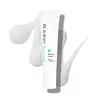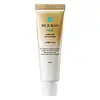What's inside
What's inside
 Key Ingredients
Key Ingredients

 Benefits
Benefits

 Concerns
Concerns

 Ingredients Side-by-side
Ingredients Side-by-side

Water
Skin ConditioningGlycerin
HumectantButylene Glycol
HumectantCaprylic/Capric Triglyceride
MaskingNiacinamide
SmoothingPanthenol
Skin ConditioningSqualane
EmollientAloe Barbadensis Leaf Juice
Skin ConditioningGlyceryl Stearate
EmollientButyrospermum Parkii Butter
Skin ConditioningHydrogenated Olive Oil Stearyl Esters
Emulsion StabilisingCucumis Sativus Fruit
Skin ConditioningCucumis Sativus Fruit Extract
EmollientAvena Sativa Kernel Extract
AbrasiveCalendula Officinalis Extract
Skin ConditioningCetearyl Alcohol
EmollientLavandula Angustifolia Flower Water
Skin ConditioningCarbomer
Emulsion StabilisingTromethamine
BufferingDipropylene Glycol
HumectantCaprylyl Glycol
EmollientEthylhexyl Olivate
Skin ConditioningHydroxyacetophenone
AntioxidantHydrolyzed Dna
Skin ConditioningSodium Acrylates Copolymer
Ceramide NP
Skin Conditioning1,2-Hexanediol
Skin ConditioningPolyglyceryl-4 Oleate
EmulsifyingAcrylates/C10-30 Alkyl Acrylate Crosspolymer
Emulsion StabilisingHydrolyzed Hyaluronic Acid
HumectantDisodium EDTA
Adenosine
Skin ConditioningLaminaria Ochroleuca Extract
Skin ConditioningCholesterol
EmollientHydrogenated Ethylhexyl Olivate
EmollientPalmitic Acid
EmollientHydrogenated Olive Oil Unsaponifiables
EmollientDipotassium Glycyrrhizate
HumectantWater, Glycerin, Butylene Glycol, Caprylic/Capric Triglyceride, Niacinamide, Panthenol, Squalane, Aloe Barbadensis Leaf Juice, Glyceryl Stearate, Butyrospermum Parkii Butter, Hydrogenated Olive Oil Stearyl Esters, Cucumis Sativus Fruit, Cucumis Sativus Fruit Extract, Avena Sativa Kernel Extract, Calendula Officinalis Extract, Cetearyl Alcohol, Lavandula Angustifolia Flower Water, Carbomer, Tromethamine, Dipropylene Glycol, Caprylyl Glycol, Ethylhexyl Olivate, Hydroxyacetophenone, Hydrolyzed Dna, Sodium Acrylates Copolymer, Ceramide NP, 1,2-Hexanediol, Polyglyceryl-4 Oleate, Acrylates/C10-30 Alkyl Acrylate Crosspolymer, Hydrolyzed Hyaluronic Acid, Disodium EDTA, Adenosine, Laminaria Ochroleuca Extract, Cholesterol, Hydrogenated Ethylhexyl Olivate, Palmitic Acid, Hydrogenated Olive Oil Unsaponifiables, Dipotassium Glycyrrhizate
Water
Skin ConditioningGlycerin
HumectantButylene Glycol
HumectantMethyl Hydrogenated Rosinate
PerfumingDipropylene Glycol
HumectantDistarch Phosphate
AbsorbentDicaprylyl Carbonate
EmollientCetearyl Alcohol
EmollientNiacinamide
SmoothingPentylene Glycol
Skin ConditioningPolyglyceryl-3 Methylglucose Distearate
Emulsifying1,2-Hexanediol
Skin ConditioningChlorella Vulgaris Extract
Skin ConditioningRh-Rice Extract
Skin ConditioningActinidia Chinensis Fruit Extract
EmollientAlthaea Rosea Flower Extract
Skin ConditioningGlycine Soja Extract
Skin ConditioningSalmon Egg Extract
Sodium Hyaluronate
HumectantBis-Diglyceryl Polyacyladipate-2
EmollientOctyldodecanol
EmollientHydroxyethyl Acrylate/Sodium Acryloyldimethyl Taurate Copolymer
Emulsion StabilisingC12-15 Alkyl Benzoate
AntimicrobialDimethicone
EmollientHydroxyacetophenone
AntioxidantGlucose
HumectantHydrolyzed Dna
Skin ConditioningAcrylates/C10-30 Alkyl Acrylate Crosspolymer
Emulsion StabilisingTromethamine
BufferingFructooligosaccharides
HumectantFructose
HumectantPanthenol
Skin ConditioningCetearyl Glucoside
EmulsifyingAdenosine
Skin ConditioningSodium Phytate
Tocopherol
AntioxidantEthylhexylglycerin
Skin ConditioningTrehalose
HumectantUrea
BufferingGlyceryl Polyacrylate
Serine
MaskingCaprylyl Glycol
EmollientAlgin
MaskingPullulan
Disodium Phosphate
BufferingPotassium Phosphate
BufferingWater, Glycerin, Butylene Glycol, Methyl Hydrogenated Rosinate, Dipropylene Glycol, Distarch Phosphate, Dicaprylyl Carbonate, Cetearyl Alcohol, Niacinamide, Pentylene Glycol, Polyglyceryl-3 Methylglucose Distearate, 1,2-Hexanediol, Chlorella Vulgaris Extract, Rh-Rice Extract, Actinidia Chinensis Fruit Extract, Althaea Rosea Flower Extract, Glycine Soja Extract, Salmon Egg Extract, Sodium Hyaluronate, Bis-Diglyceryl Polyacyladipate-2, Octyldodecanol, Hydroxyethyl Acrylate/Sodium Acryloyldimethyl Taurate Copolymer, C12-15 Alkyl Benzoate, Dimethicone, Hydroxyacetophenone, Glucose, Hydrolyzed Dna, Acrylates/C10-30 Alkyl Acrylate Crosspolymer, Tromethamine, Fructooligosaccharides, Fructose, Panthenol, Cetearyl Glucoside, Adenosine, Sodium Phytate, Tocopherol, Ethylhexylglycerin, Trehalose, Urea, Glyceryl Polyacrylate, Serine, Caprylyl Glycol, Algin, Pullulan, Disodium Phosphate, Potassium Phosphate
Ingredients Explained
These ingredients are found in both products.
Ingredients higher up in an ingredient list are typically present in a larger amount.
1,2-Hexanediol is a synthetic liquid and another multi-functional powerhouse.
It is a:
- Humectant, drawing moisture into the skin
- Emollient, helping to soften skin
- Solvent, dispersing and stabilizing formulas
- Preservative booster, enhancing the antimicrobial activity of other preservatives
Acrylates/C10-30 Alkyl Acrylate Crosspolymer is a synthetic polymer. It is used to thicken and improve the texture of products. Due to its properties, it can prevent water and oil ingredients from separating.
Adenosine is in every living organism. It is one of four components in nucleic acids that helps store our DNA.
Adenosine has many benefits when used. These benefits include hydrating the skin, smoothing skin, and reducing wrinkles. Once applied, adenosine increases collagen production. It also helps with improving firmness and tissue repair.
Studies have found adenosine may also help with wound healing.
In skincare products, Adenosine is usually derived from yeast.
Learn more about AdenosineButylene Glycol (or BG) is used within cosmetic products for a few different reasons:
Overall, Butylene Glycol is a safe and well-rounded ingredient that works well with other ingredients.
Though this ingredient works well with most skin types, some people with sensitive skin may experience a reaction such as allergic rashes, closed comedones, or itchiness.
Learn more about Butylene GlycolCaprylyl Glycol is a humectant and emollient, meaning it attracts and preserves moisture.
It is a common ingredient in many products, especially those designed to hydrate skin. The primary benefits are retaining moisture, skin softening, and promoting a healthy skin barrier.
Though Caprylyl Glycol is an alcohol derived from fatty acids, it is not the kind that can dry out skin.
This ingredient is also used as a preservative to extend the life of products. It has slight antimicrobial properties.
Learn more about Caprylyl GlycolCetearyl alcohol is a mixture of two fatty alcohols: cetyl alcohol and stearyl alcohol. It is mainly used as an emulsifier. Emulsifiers help prevent the separation of oils and products. Due to its composition, it can also be used to thicken a product or help create foam.
Cetearyl alcohol is an emollient. Emollients help soothe and hydrate the skin by trapping moisture.
Studies show Cetearyl alcohol is non-toxic and non-irritating. The FDA allows products labeled "alcohol-free" to have fatty alcohols.
This ingredient is usually derived from plant oils such as palm, vegetable, or coconut oils. There is debate on whether this ingredient will cause acne.
Due to the fatty acid base, this ingredient may not be Malassezia folliculitis safe.
Learn more about Cetearyl AlcoholDipropylene Glycol is a synthetically created humectant, stabilizer, and solvent.
This ingredient helps:
Dipropylene glycol is technically an alcohol, but it belongs to the glycol family (often considered part of the ‘good’ alcohols). This means it is hydrating and gentle on skin unlike drying solvent alcohols like denatured alcohol.
As a masking agent, Dipropylene Glycol can be used to cover the smell of other ingredients. However, it does not have a scent.
Studies show Dipropylene Glycol is considered safe to use in skincare.
Learn more about Dipropylene GlycolGlycerin is already naturally found in your skin. It helps moisturize and protect your skin.
A study from 2016 found glycerin to be more effective as a humectant than AHAs and hyaluronic acid.
As a humectant, it helps the skin stay hydrated by pulling moisture to your skin. The low molecular weight of glycerin allows it to pull moisture into the deeper layers of your skin.
Hydrated skin improves your skin barrier; Your skin barrier helps protect against irritants and bacteria.
Glycerin has also been found to have antimicrobial and antiviral properties. Due to these properties, glycerin is often used in wound and burn treatments.
In cosmetics, glycerin is usually derived from plants such as soybean or palm. However, it can also be sourced from animals, such as tallow or animal fat.
This ingredient is organic, colorless, odorless, and non-toxic.
Glycerin is the name for this ingredient in American English. British English uses Glycerol/Glycerine.
Learn more about GlycerinWe don't have a description for Hydrolyzed Dna yet.
Hydroxyacetophenone is antioxidant with skin conditioning and soothing properties. It also boosts the efficiency of preservatives.
This ingredient is not irritating or sensitizing.
Niacinamide is a multitasking form of vitamin B3 that strengthens the skin barrier, reduces pores and dark spots, regulates oil, and improves signs of aging.
And the best part? It's gentle and well-tolerated by most skin types, including sensitive and reactive skin.
You might have heard of "niacin flush", or the reddening of skin that causes itchiness. Niacinamide has not been found to cause this.
In very rare cases, some individuals may not be able to tolerate niacinamide at all or experience an allergic reaction to it.
If you are experiencing flaking, irritation, and dryness with this ingredient, be sure to double check all your products as this ingredient can be found in all categories of skincare.
When incorporating niacinamide into your routine, look out for concentration amounts. Typically, 5% niacinamide provides benefits such as fading dark spots. However, if you have sensitive skin, it is better to begin with a smaller concentration.
When you apply niacinamide to your skin, your body converts it into nicotinamide adenine dinucleotide (NAD). NAD is an essential coenzyme that is already found in your cells as "fuel" and powers countless biological processes.
In your skin, NAD helps repair cell damage, produce new healthy cells, support collagen production, strengthen the skin barrier, and fight environmental stressors (like UV and pollution).
Our natural NAD levels start to decline with age, leading to slower skin repair, visible aging, and a weaker skin barrier. By providing your skin niacinamide, you're recharging your skin's NAD levels. This leads to stronger, healthier, and younger looking skin.
Another name for vitamin B3 is nicotinamide. This vitamin is water-soluble and our bodies don't store it. We obtain Vitamin B3 from either food or skincare. Meat, fish, wheat, yeast, and leafy greens contain vitamin B3.
The type of niacinamide used in skincare is synthetically created.
Learn more about NiacinamidePanthenol is a common ingredient that helps hydrate and soothe the skin. It is found naturally in our skin and hair.
There are two forms of panthenol: D and L.
D-panthenol is also known as dexpanthenol. Most cosmetics use dexpanthenol or a mixture of D and L-panthenol.
Panthenol is famous due to its ability to go deeper into the skin's layers. Using this ingredient has numerous pros (and no cons):
Like hyaluronic acid, panthenol is a humectant. Humectants are able to bind and hold large amounts of water to keep skin hydrated.
This ingredient works well for wound healing. It works by increasing tissue in the wound and helps close open wounds.
Once oxidized, panthenol converts to pantothenic acid. Panthothenic acid is found in all living cells.
This ingredient is also referred to as pro-vitamin B5.
Learn more about PanthenolTromethamine helps balance the pH and improve the texture of a product. It is synthetically created.
As an emulsifier, Tromethamine prevents oil and water ingredients from separating. This helps stabilize the product and elongate a product's shelf life. Tromethamine also makes a product thicker.
Tromethamine helps balance the pH level of a product. Normal pH level of skin is slightly acidic (~4.75-5.5). The acidity of our skin is maintained by our glands and skin biome. Being slightly acidic allows our skin to create an "acid mantle". This acid mantle is a thin barrier that protects our skin from bacteria and contaminants.
Oral Tromethanmine is an anti-inflammatory drug but plays the role of masking, adding fragrance, and/or balancing pH in skincare.
1,3-Propanediol, 2-amino-2-(hydroxymethyl)-
Learn more about TromethamineWater. It's the most common cosmetic ingredient of all. You'll usually see it at the top of ingredient lists, meaning that it makes up the largest part of the product.
So why is it so popular? Water most often acts as a solvent - this means that it helps dissolve other ingredients into the formulation.
You'll also recognize water as that liquid we all need to stay alive. If you see this, drink a glass of water. Stay hydrated!
Learn more about Water